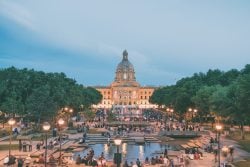The 5 Most Common Languages Spoken in Canada
When we visit Canada, we are already expecting to hear both English and French everywhere we go. But are there other languages we should keep an ear tuned into hearing as well? Of course there are! Here are the five most commonly spoken languages you’ll find in Canada. What do you think you’ll see on the list?

Montreal via Pixabay / Pixabay
English
Okay, so it won’t come as a surprise to anyone that English is the most widely spoken language of Canada. Around 20 million Canadians listed English as a first language in 2017. English is one of Canada’s two official languages, so its high level of usage is to be expected as the prefered language for around 60 percent of the population.
Almost every street sign, government document, and public transport guide will be displayed in either English alone, or along with French. This year marks the 50th anniversary of the Official Languages Act, which gives citizens of Canada the right to communicate with the federal government and receive government services in their official language of choice, either French or English.
Learning a new language? Check out our free placement test to see how your level measures up!
French
French is naturally next on our list, though the difference between the numbers of English and French speakers is more than we thought! Those that list French as their first language total just under 7.5 million. That is barely 20 percent of the population! 98 percent of Canadians say that they can hold a conversation in English, French, or both, meaning Canada is impressively bilingual.
You’ll find most Francophones in the Quebec region, where 77 percent of the population list French as their first language. Perhaps this is the area where you’ll find the most alarm that the number of French-speaking Canadians is on the decline – though enrollment in French immersion schooling has increased by about 20 percent in recent years. As Oprah would say, what is the truth?

Vancouver via Pixabay / Pixabay
Mandarin
Mandarin is spoken as a mother tongue by around eight percent of Canada, which works out to about 610,000 speakers. It is considered an immigrant language, which for Canada tends to belong to one of 23 language families. You’ll most likely find Mandarin speakers in Canada’s largest metropolitan areas, like Calgary, Ottawa–Gatineau, and of course Vancouver. And with a large Mandarin-speaking population you’d be right to expect great Chinese cuisine; WWE star John Cena certainly seemed to think so on a recent visit to his favourite restaurant in Vancouver. Here he is, showing off his Mandarin skills.
Cantonese
Cantonese used to be the more widely spoken Chinese language of Canada, but has now been usurped by Mandarin. Though not by much! 594,000 people list Cantonese as their mother tongue, accounting for 7.7 percent of the total population. Again you will find most Canadian Cantonese speakers in the country’s larger cities. Immigration from Hong Kong and Guangdong has fallen steeply over the last couple of decades which probably accounts for the switch in popularity from Cantonese to Mandarin.

Edmonton via Flickr / Flickr
Punjabi
Punjabi is spoken by almost 544,000 people, making up seven percent of Canada’s total population. Vancouver, Calgary, and Edmonton is home to most of Canada’s Punjabi speakers, and Punjabi has become the third language of Canadian parliament after English and French. With Hockey Night In Canada in Punjabi attracting thousands of viewers and putting a spotlight on the beautiful language that is Punjabi, many Canadians wonder if Punjabi might one day be the country’s third official language.
Best of the rest
Canada has long been considered a migrant country, so its richness in language diversity should come as no surprise. One in five Canadians speaks a language other than English or French at home. Tagalog, a language of the Philippines, is on the increase, with growth of around 35 percent in speaker numbers in recent censuses.
We must also not forget the aboriginal, indigenous languages of Canada, with more than 60 of them spanning 12 language families in recent censuses. The largest family we see speakers from is the Algonquian family, specifically Cree, Ojibway and Innu languages.
In short, Canada is home to a beautiful array of languages that goes beyond just English and French. Which are you now tempted to learn?
